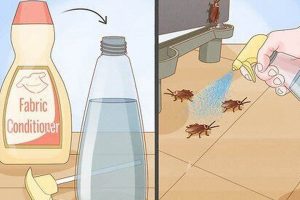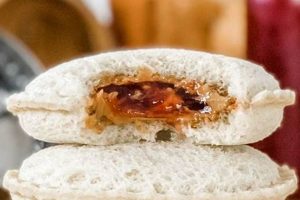The practice of creating personalized hair care formulations at home, using readily available ingredients, offers an alternative to commercially produced products. This approach allows for customization based on individual hair type, sensitivities, and specific needs. For example, a mixture of coconut oil and honey can serve as a hydrating and softening treatment for dry hair.
Formulating custom hair treatments can provide control over ingredients, potentially reducing exposure to synthetic chemicals and fragrances. Historically, individuals relied on natural resources for personal care; modern adaptations provide cost-effectiveness and a connection to traditional practices. Further, this approach enables experimentation with formulations to achieve desired aesthetic and functional results.
The subsequent discussion will delve into the selection of suitable ingredients, appropriate techniques for creating effective treatments, and precautions to ensure safe and satisfactory outcomes. Consideration will also be given to storage and shelf-life considerations to maintain product integrity.
Essential Considerations for Creating Personalized Hair Treatments
The effective creation of personalized hair treatments requires careful attention to detail and a comprehensive understanding of ingredients and their properties.
Tip 1: Ingredient Selection: Prioritize high-quality, natural ingredients such as plant-based oils, butters, and extracts. Consider the specific benefits of each ingredient and its suitability for the target hair type.
Tip 2: Formulation Consistency: Aim for a smooth, even consistency in the final product. Lumps or uneven mixing can hinder application and reduce effectiveness.
Tip 3: Patch Testing: Before applying a homemade treatment to the entire scalp and hair, conduct a patch test on a small area to identify potential allergic reactions or sensitivities.
Tip 4: Hygiene Practices: Employ sterile containers and utensils during the mixing and storage process to prevent bacterial contamination and extend the shelf life of the product.
Tip 5: Proper Application: Distribute the treatment evenly throughout the hair, focusing on areas that require the most attention. Consider using a wide-tooth comb to ensure thorough coverage.
Tip 6: Rinsing Thoroughly: After the treatment has been applied for the recommended duration, rinse thoroughly with lukewarm water until all traces of the product are removed. Residual product can lead to buildup and unwanted texture.
Tip 7: pH Balance: Test the pH level of the final product, and adjust where necessary to ensure it is compatible with the natural pH of the scalp and hair. An imbalanced pH can lead to irritation or damage.
These considerations will help to promote product efficacy, ensure user safety, and maintain the overall health and vitality of the hair.
The following section will address common challenges and frequently asked questions related to personalized hair care.
1. Ingredient Quality
The efficacy of homemade hair treatments is directly contingent upon the caliber of the components employed. Inferior or adulterated ingredients can compromise the product’s ability to deliver desired benefits, and may even induce adverse reactions. For example, using rancid oil in a hydrating hair mask can result in an unpleasant odor and potential scalp irritation, negating any potential moisturizing effects.
The use of pure, unrefined oils, organic extracts, and food-grade additives is paramount. These ingredients provide the optimal balance of nutrients and minimize the risk of contamination with harmful chemicals. For instance, substituting refined coconut oil with its unrefined counterpart can improve hair strength and reduce protein loss due to the higher concentration of lauric acid and other beneficial fatty acids. Selecting preservatives such as grapefruit seed extract or rosemary oleoresin effectively inhibits microbial growth and maintains the stability of the homemade hair treatment, extending shelf life.
Prioritizing ingredient provenance and certifications is crucial. Ingredients from reputable suppliers with verifiable quality control measures ensure the absence of undesirable substances and guarantee potency. The selection of high-quality ingredients not only enhances the effectiveness of homemade hair treatments but also contributes to a safer and more sustainable personal care regimen.
2. Formulation Balance
The efficacy of a homemade hair treatment rests significantly on the equilibrium achieved within its formulation. An imbalance can negate the intended benefits, leading to undesirable outcomes ranging from ineffective conditioning to scalp irritation. The concept of formulation balance entails the careful selection and proportioning of ingredients to create a synergistic effect. For example, a treatment intended to moisturize dry hair might include humectants, emollients, and occlusives in appropriate ratios. An excess of humectants, like glycerin or honey, in a low-humidity environment can draw moisture from the hair, rather than to it, resulting in dryness. Conversely, an overabundance of occlusives, such as heavy oils like shea butter, can lead to product buildup and a greasy feel.
Achieving this balance requires a thorough understanding of each ingredient’s properties and its potential interaction with others. Proteins, oils, humectants, and herbs play distinct roles in hair health. Furthermore, hair porosity and scalp type need consideration during formulation. High porosity hair, for instance, may require a greater proportion of protein-rich ingredients. Oily scalps typically benefit from lightweight, non-comedogenic oils and astringent herbs, while dry scalps require heavier emollients and soothing herbs. Proper balance also considers the product’s pH; maintaining a slightly acidic pH close to the hair’s natural pH (around 4.5-5.5) is critical to preserve the cuticles integrity.
Therefore, the formulation balance is not merely a matter of combining ingredients but of understanding their individual and collective impact on hair health. Experimentation and meticulous observation are essential. By carefully adjusting ingredient ratios based on observed results, one can create a customized hair treatment that delivers optimal conditioning and promotes long-term hair health. A lack of attention to balance creates formulations that do not reach their full potential and may trigger undesirable effects.
3. Scalp Sensitivity
Scalp sensitivity represents a critical consideration when formulating personalized hair treatments. An irritate
d or inflamed scalp can exhibit reactions to a wide range of substances, including natural ingredients often incorporated into homemade hair products. Pre-existing conditions such as eczema, psoriasis, or seborrheic dermatitis can exacerbate these sensitivities. The cause-and-effect relationship is direct: an incompatible ingredient triggers an inflammatory response, manifesting as itching, redness, burning, or even scaling. For example, essential oils, while beneficial in diluted forms, can cause severe irritation if applied undiluted to a sensitive scalp. Similarly, even natural ingredients like honey or lemon juice can trigger reactions in individuals with specific allergies or sensitivities.
Understanding scalp sensitivity is paramount in crafting hair treatments. The absence of synthetic preservatives in many homemade formulations necessitates careful ingredient selection. The use of gentle, hypoallergenic options, such as aloe vera or chamomile, can mitigate the risk of adverse reactions. Conducting a patch test before applying a homemade treatment to the entire scalp is imperative. This involves applying a small amount of the product to a discreet area, such as behind the ear, and monitoring for any signs of irritation over a 24-48 hour period. If any adverse reactions occur, the formulation should be avoided. The pH of the diy hair treatment should closely match the natural pH of the scalp (around 5.5) to minimize disruption to the acid mantle and the resultant potential for sensitivity.
In summary, addressing scalp sensitivity is not merely a precautionary measure; it is a fundamental aspect of creating safe and effective homemade hair treatments. By prioritizing gentle ingredients, conducting patch tests, and maintaining pH balance, the risk of adverse reactions is significantly reduced. The practical significance lies in ensuring that homemade hair treatments enhance hair health without compromising scalp integrity.
4. Application Technique
The methodology employed in applying homemade hair treatments significantly influences the efficacy of the product. Proper technique ensures optimal distribution, penetration, and retention of beneficial ingredients, maximizing their impact on hair health.
- Even Distribution
Achieving uniform coverage of the hair shaft is paramount. Uneven distribution can lead to inconsistent conditioning, with some areas receiving inadequate treatment while others experience product overload. A wide-tooth comb or applicator brush facilitates even distribution, particularly for thicker hair types. Consistent application from root to tip ensures all strands benefit from the formulation.
- Optimal Saturation
Saturation refers to the degree to which the hair is infused with the treatment. Insufficient saturation limits the absorption of beneficial ingredients, reducing the treatment’s effectiveness. Conversely, excessive saturation can lead to product buildup and difficulty rinsing. The goal is to achieve thorough saturation without weighing the hair down. The texture and porosity of the hair dictate the optimal level of saturation; finer, low-porosity hair requires less product than coarse, high-porosity hair.
- Appropriate Dwell Time
Dwell time, or the duration the treatment remains on the hair, is a crucial factor. Insufficient dwell time limits the opportunity for ingredients to penetrate the hair shaft, diminishing the conditioning effect. Prolonged dwell time, however, can lead to dryness or irritation in some individuals. The ideal dwell time is contingent upon the ingredients used, the hair’s condition, and individual sensitivity. Regularly, 20-30 minutes is recommended, but experimentation may be necessary.
- Rinsing Thoroughness
Complete removal of the treatment during rinsing is vital to prevent product buildup and scalp irritation. Inadequate rinsing leaves residue on the hair, leading to dullness, stiffness, and potential scalp issues. Lukewarm water is generally preferred for rinsing, as it effectively removes residue without stripping the hair of its natural oils. Thorough rinsing continues until the water runs clear, indicating complete product removal.
The facets of application technique even distribution, optimal saturation, appropriate dwell time, and rinsing thoroughness collectively determine the overall outcome of the homemade hair treatment. By paying careful attention to these elements, individuals can optimize the conditioning benefits and maintain the health and appearance of their hair.
5. Storage Method
The method by which homemade hair treatments are stored profoundly influences their stability, safety, and continued efficacy. Appropriate storage minimizes the risk of microbial contamination, oxidation, and degradation of active ingredients, preserving the product’s intended benefits.
- Container Material
The selection of the container material significantly impacts product longevity. Dark-colored glass containers are generally preferred over plastic, as they minimize light exposure, which can degrade light-sensitive ingredients like essential oils. Glass is also less prone to leaching chemicals into the formulation, maintaining its purity. Proper sanitation of the container, using methods such as boiling or sterilizing with alcohol, is vital to prevent bacterial introduction.
- Temperature Control
Storage temperature plays a critical role in preventing spoilage. High temperatures accelerate oxidation and microbial growth, reducing the shelf life of the hair treatment. Storing homemade formulations in a cool, dark location, such as a refrigerator, slows these processes and maintains product integrity. Freezing is generally not recommended as it can alter the texture and stability of emulsions.
- Airtight Seal
Exposure to air promotes oxidation and can introduce contaminants. Ensuring an airtight seal on the storage container is essential to minimize these risks. Containers with tight-fitting lids or airtight closures are preferable. Proper sealing also prevents the loss of volatile components, such as essential oils, preserving the product’s aroma and therapeutic properties.
- Labeling and Dating
Clear labeling and dating of stored formulations are essential for maintaining safety and preventing the use of expired products. The label should include a list of ingredients and the date of preparation. Discarding the product after a specified timeframe, typically within a few weeks to a few months depending on the ingredients, prevents the use of degraded or contaminated treatments.
These factors regarding the storage of homemade hair treatments collectively determine their ultimate quality and safety. Ignoring these considerations may result in ineffective or even harmful products. By adhering to appropriate storage protocols, consumers can confidently create and utilize homemade hair treatments, maximizing their potential benefits while mitigating risks.
Frequently Asked Questions Regarding DIY Conditioner
The following questions address common concerns and misconceptions associated with the creation and use of homemade hair conditioning treatments. These responses aim to provide clarity and promote safe, effective practices.
Question 1: Is a homemade hair conditioner
as effective as a commercially produced product?
The efficacy of a conditioner formulated at home depends entirely on the ingredients selected and the precision of the formulation. A well-researched and carefully prepared treatment utilizing high-quality components can yield comparable, or even superior, results to many commercially available options. Key benefits are the omission of synthetic additives and the ability to tailor the formulation to specific hair needs.
Question 2: What is the typical shelf life of a DIY conditioner?
The longevity of a homemade hair conditioner is contingent on the ingredients employed and the storage conditions. In the absence of preservatives, formulations containing fresh ingredients, such as fruits or vegetables, typically have a shelf life of only a few days when refrigerated. Oil-based formulations, stored in airtight containers in a cool, dark location, may remain viable for several weeks. Meticulous observation of the product’s appearance and odor is critical to detect signs of spoilage.
Question 3: Can homemade conditioners be used on color-treated hair?
The compatibility of homemade conditioners with color-treated hair warrants careful consideration. Certain ingredients, such as lemon juice or vinegar, possess acidic properties that may affect hair color vibrancy. Formulations containing oils can potentially accelerate color fading. Performing a strand test before applying a homemade conditioner to the entire head of color-treated hair is highly advisable.
Question 4: What ingredients should be avoided in DIY conditioner formulations?
Certain ingredients are inadvisable for inclusion in homemade hair conditioning treatments due to potential risks. Undiluted essential oils can cause scalp irritation. Food ingredients prone to spoilage, such as milk or eggs, present a higher risk of bacterial contamination. Furthermore, individuals with known allergies should meticulously avoid those allergens in their formulations.
Question 5: How does one determine the correct consistency for a homemade hair conditioner?
The ideal consistency of a homemade hair conditioner depends on the hair type and application preferences. Thicker consistencies are generally suitable for dry, coarse hair, while thinner consistencies are better suited for fine or oily hair. The formulation should be easily spreadable and rinse cleanly from the hair. Adjustments to the consistency can be achieved by modifying the proportions of liquid and solid ingredients.
Question 6: Is it necessary to use a preservative in a homemade hair conditioner?
The inclusion of a preservative in a homemade hair conditioner is advisable, particularly when the formulation contains water or other ingredients susceptible to microbial growth. Preservatives such as grapefruit seed extract or rosemary oleoresin extend the shelf life of the product and minimize the risk of contamination. However, it is crucial to use preservatives at the recommended concentrations to avoid irritation or other adverse effects.
The careful consideration of these points can contribute to a safer, more satisfactory experience with homemade hair conditioning treatments. Prioritizing research, ingredient quality, and meticulous preparation is paramount.
The next section will address potential challenges encountered when creating homemade hair conditioners and offer strategies for overcoming them.
Conclusion
This exploration of homemade hair conditioning treatments has emphasized the need for meticulous attention to detail in all stages of the process. Ingredient selection, formulation balance, consideration of scalp sensitivities, application technique, and appropriate storage methods collectively determine the safety and efficacy of the final product. Successfully integrating these elements is critical for achieving optimal conditioning results.
The informed creation and use of DIY conditioner, while demanding vigilance and research, offers an opportunity for customization and control over ingredients not typically found in commercial products. Continued research and adherence to best practices will further refine homemade hair care approaches, allowing for more sophisticated and effective solutions for individual needs.







